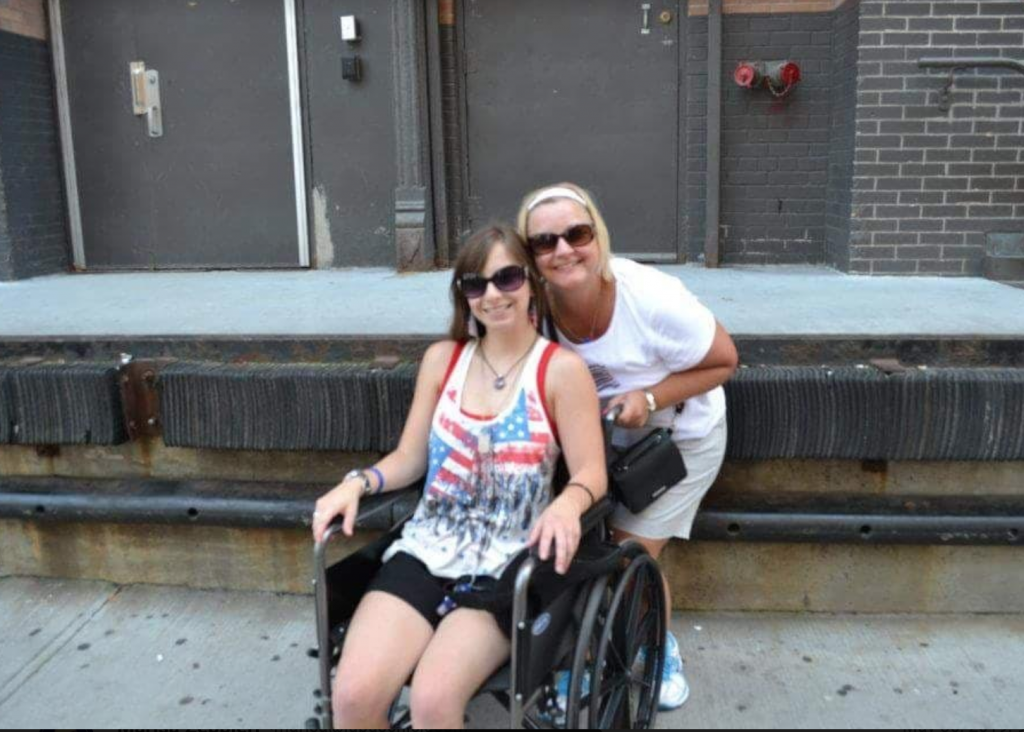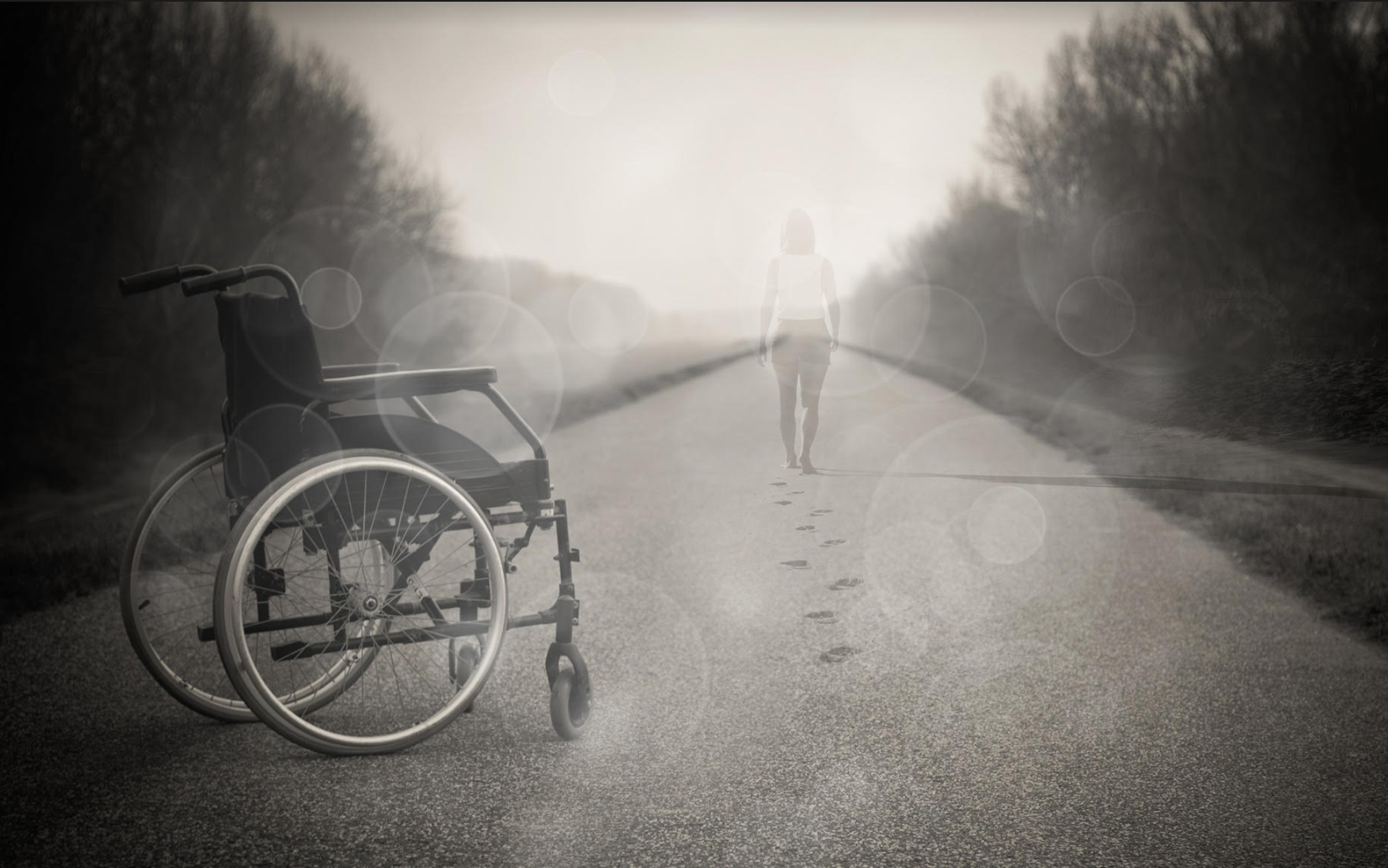By guest writer, Mariana Abeid-McDougall
When Felix Walters was waiting for the bus to get home from work one day, she was feeling a little more confident in her walking ability. She stood up from her wheelchair to push it onto the bus. The driver made an obscene gesture and kept driving past the bus stop. Walters has ehler-danlos syndrome, which causes sudden and frequent dislocations, as well as other comorbidities that make walking long distances difficult.

Because of the discrimination and judgment she has faced as an ambulatory wheelchair user, she doesn’t use her mobility aids as often, which can cause further injury to her unstable joints. Felix is not alone in facing a public that doesn’t believe her illnesses.
Alicia Wilson has nine conditions, three of which are rare. They cause her to faint and fall easily, so using a wheelchair or a scooter is a matter of safety. It’s often easier for her to use the scooter available at stores for shopping than to bring her own, as this leaves space in the trunk for groceries. She has received “nasty looks and been called all kinds of nasty names for taking the last electric scooter at a store by an older person who felt [she] didn’t need it.”
She has also “gotten all kinds of nasty looks parking in a handicap spot and walking into a store.” People tell Wilson that she looks healthy. She says “I have a PICC line and a feeding tube. Most healthy people don’t have those.” Sometimes, the disbelief of strangers makes Wilson “pretty upset.” Other times, she tells herself she’s having a hard day, and they must be having a hard day, too. While this outlook can help Wilson cope with her experiences, others face a worsening in their health when dealing with these confrontations.
Cassie Borland has faced severe discrimination, including physical abuse for being a part-time wheelchair user. This abuse comes not just from the general public, but from medical professionals, too. Borland has several conditions that cause weakness, dizziness, and difficulty breathing, making walking both difficult as well as dangerous. At one point, one of these conditions caused temporary paralysis from the waist down. The doctor she saw at the time picked her up from the bed and told her to walk. Wilson collapsed and tore her knee, requiring surgery. Borland has been pushed out of the way at stores, pushed down an embankment while in her wheelchair, and had people tell her to get out of her wheelchair and “give them a turn” because they were tired and she “can walk anyway.” For Borland, these confrontations cause severe stress, to which her body responds via fainting or having seizures.
Dealing with Disability Ignorance
People who “don’t look disabled” often face discrimination. Every day, ambulatory wheelchair users face harassment at the hands of a public that doesn’t understand their needs. Whereas most people are familiar with paraplegia, quadriplegia, or other spinal cord injuries requiring wheelchair use, very few people understand that many other illnesses, including but not limited to rheumatoid arthritis, ehler-danlos syndrome, narcolepsy, and other conditions that cause extreme fatigue or pain (and can require mobility aids).
Unfortunately, the experience of ambulatory wheelchair users shows that a large percentage of the public, including people who work with persons with disabilities, are not aware that most wheelchair users can walk for short distances. Other part-time wheelchair users can often walk for longer distances when they’re having a day with fewer symptoms. Because ambulatory wheelchair users often stand or walk, they hear some hurtful words and get judgment from strangers who think they’re “faking it.”
Flipping the Script on Discrimination
The stories of discrimination, bullying, and disrespect are many, and part-time wheelchair users often face them from the time they’re very young. Often, this discrimination is both emotionally and physically painful. Sometimes, this discrimination turns into a catalyst for activism.
As a young person with “invisible illnesses,” Ola Ojewumi faced severe bullying and discrimination which hurt her but also catapulted a career in politics. Ojewumi has mitochondrial disease, which affects her energy levels. “Walking a block for me is like walking a mile for the average person.” According to the United Mitochondrial Disease Foundation, when mitochondria fail, there’s less and less energy available to the cells and whole organ systems can begin to fail as well.
When Ojewumi was young, she had a kidney and heart transplant, which, in addition to the mitochondrial disease, made walking difficult. This led to fainting spells and falls. Ojewumi once tripped on the stairs because of nerve damage to her legs, and the other children in her middle school laughed at her. While we could say “these kids didn’t know any better,” the bullying and ill-treatment didn’t end with her schoolmates. A teacher once told her, “You had your heart transplant four years ago; you’re fine now.” The judgment continued after she graduated.
In her employment experience, Ojewumi has also faced discrimination. Her wheelchair is a necessity to get to meetings on time. But when she gets up and walks, people feel she doesn’t need the chair. Ojewumi says, “I have great sadness on my end that people think I’m some sort of fraud; it’s just hard to walk…. I couldn’t keep clutching my chest or being constantly out of breath. I need the wheelchair to function in an able-bodied world.”
Ola has been denied access to accommodations, such as working from home some of the time, for employers’ fears that able-bodied workers will want the same accommodations. When she’s not being given excuses for why accommodations can’t happen, she’s facing criticism or sideways glances from people who don’t believe her need for mobility aids.
“Illness and disability don’t check the calendar. It just exists. A 20-year-old has as much right to use a mobility aid or a disabled parking spot (provided they have tags) as an 80-year-old. And we shouldn’t have to explain ourselves.” – Katelyn Ducky Bush
Mobility Aids and Increased Freedom
There’s a general belief among the public that people who use wheelchairs are “confined to them.” This belief is hurtful to both people who use wheelchairs all of the time and to those who need it some of the time. People aren’t “confined to wheelchairs;” they are wheelchair users, whose mobility aids give them freedom. Ojewumi says, “My wheelchair gave me life when I didn’t have one. I grew up without a lot of friends because I couldn’t keep up with the other kids. I couldn’t go to the mall or movie theatre because I couldn’t walk. When I got my wheelchair at 20, boom, I had a life, I could go out.”
Ojewumi is not alone in feeling this way.
In August 2018, the hashtag #AmbulatoryWheelchairUsersExist appeared on Twitter and Instagram, in response to reports of a 10-year-old boy getting up from his wheelchair for the national anthem at an event. Fox News (and the boys’ parents) called the act “patriotic.” Annie Segarra, a YouTuber and LGBT and disability advocate, started the hashtag, which is intended to bring attention to ambulatory wheelchair users. In response, several people who use wheelchairs on a part-time basis have shared their stories of discrimination and judgment, but also of freedom—the freedom that their chairs bring to their lives.
While their wheelchairs are a positive in their lives, the society around ambulatory wheelchair users causes them pain, sadness, and sometimes consequences as serious as post traumatic stress disorder for the mistreatment they face. People who need mobility aids are often not believed when they use their equipment. There’s a general assumption that a person with a disability looks a certain way, but people who need mobility aids part-time often don’t fit that description. This is particularly true of young people.

Katelyn Ducky Bush has heard she’s “too young to be this sick” her entire life, having been born with a heart condition that makes exercise extremely difficult. She wishes people would understand that “illness and disability don’t check the calendar. It just exists. A 20-year-old has as much right to use a mobility aid or a disabled parking spot (provided they have tags) as an 80-year-old. And we shouldn’t have to explain ourselves.”
Many people with disabilities do feel like they need to explain themselves, because the public seems to have a preconceived idea of what a person with a disability should look like. When people harass ambulatory wheelchair users, they often think they’re doing a service to people with disabilities by, for example, calling out what they think is abuse of parking badges. However, they don’t realize they’re hurting the very people they purport to want to help, because they don’t understand that those who don’t “look disabled” (whatever that means) need accommodations, too.
Some people chalk this up to ignorance and are eager to educate—as long as questions are asked politely. My 6-year-old daughter once asked loudly, “Why is she in a wheelchair?” The little girl’s mother politely answered my daughter’s question and said, “Thank you for asking.” For other people with disabilities, questions about their personal health are considered rude and unacceptable, and some feel that even asking questions is a show of discrimination—why is it OK to ask them about their health, when, if they weren’t disabled, these questions would seem rude? Even in the way that people react to questions and interactions, people with disabilities vary widely.
Fighting Judgment With Education
We need the public to understand that there is diversity within the disabled community. Disabilities and illnesses can look very different (or it can look like they are not there at all). We are making progress recognizing that not all disabilities are visible. Ojewumi is one of the people advocating for all people with disabilities, no matter what they look like. Her charity, Project Ascend, offers scholarships to the disabled. The charity makes it clear that the scholarships are open to anyone with disabilities, whether those disabilities are visible or not. In addition to offering services to all who need it, Ojewumi believes that PSAs explaining invisible illnesses would make a difference in teaching the public to be less judgemental towards ambulatory wheelchair users.
Disability encompasses a lot of different illnesses and conditions—and mobility equipment isn’t reserved only for the paralyzed. We need the public to understand that the use of mobility aids is not theirs to police, and that if someone is using something, you should just accept that they need it. Yes, there are some people who abuse the system. But there are far more people who have a parking badge and a wheelchair who actually need those accommodations than people who go to all that trouble just to park closer to the building. If you see someone using a service or mobility aid, don’t judge them, because you don’t have enough information about their condition(s). And as Ojewumi says, “If you want the wheelchair and the parking badge, you’ll need to take her disability, too.”
Note: The disability community is diverse. Some people prefer to be called “disabled people” while others prefer the term “person with a disability.” The author has used person-first language, as this is her preferred use as a person with several chronic illnesses.

About Mariana Abeid-McDougall
Mariana Abeid-McDougall is a multi-niche freelance writer, editor and mom of three in an out-of-the-box, adventurous family. She blogs about family adventure travel, health, and more at www.marianamcdougall.com.

I have EDS clasical type 1 and SLE. I was so happy to see a fellow zebra listed. Sending love to all of us fighting something!
I really liked the article on ambulatory wheelchair users and invisible disabilities. I cope with this myself and identified with a lot of things in the article. I’m not happy that others face the same battles but I am happy to know I’m not fighting alone because together people are stronger. Getting people educated is the first step in the right direction. Now with the pandemic it’s even harder.